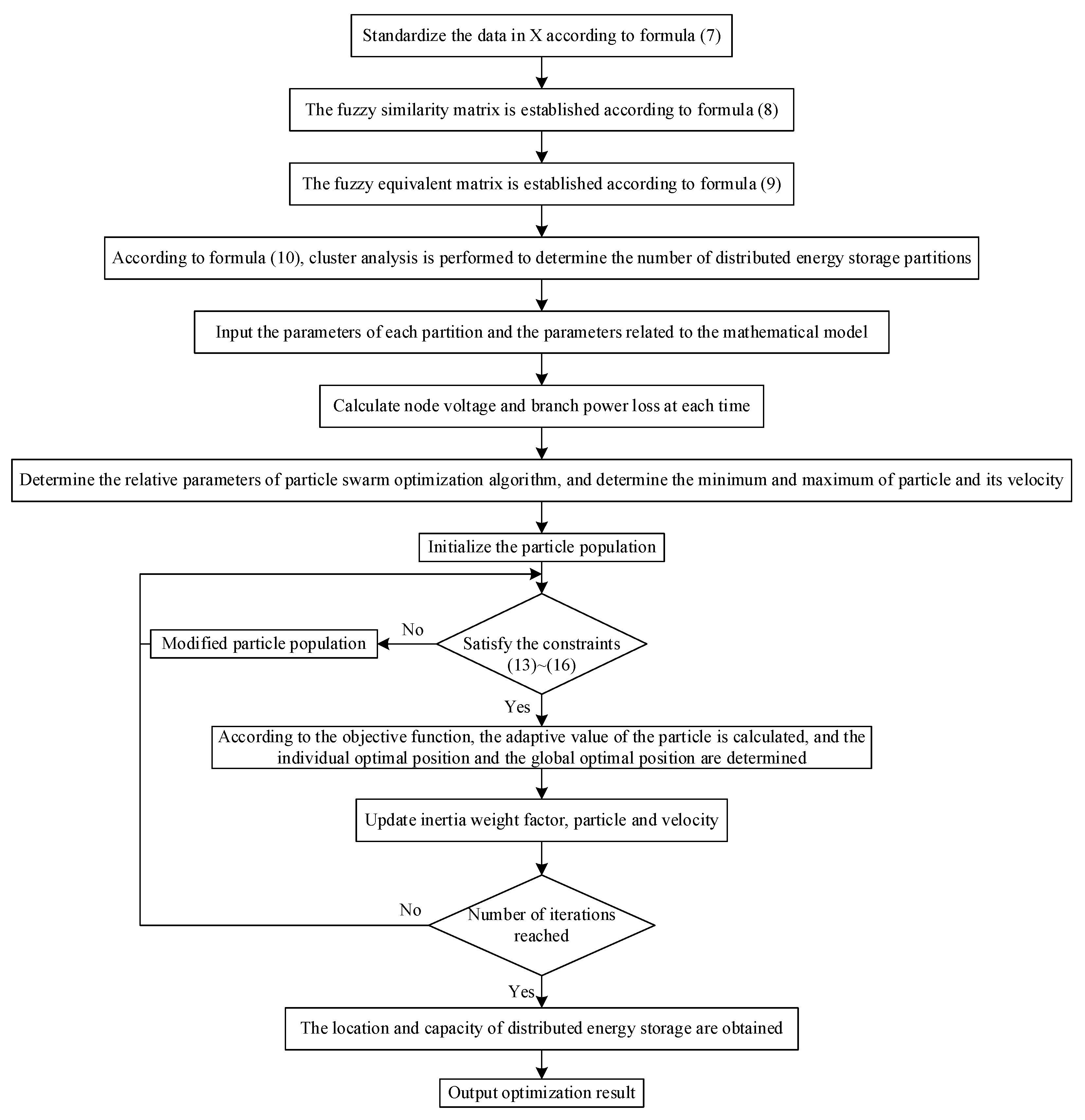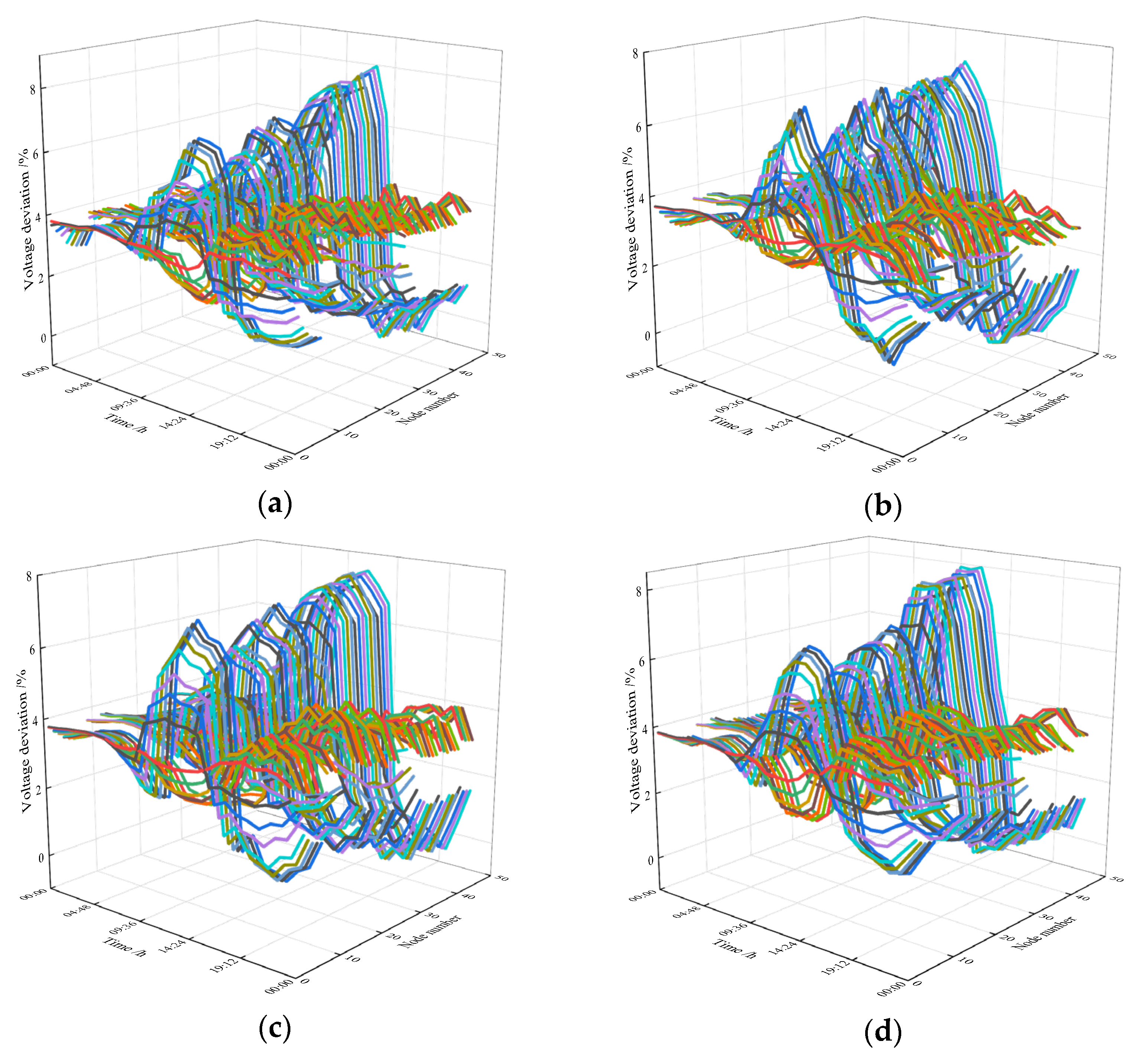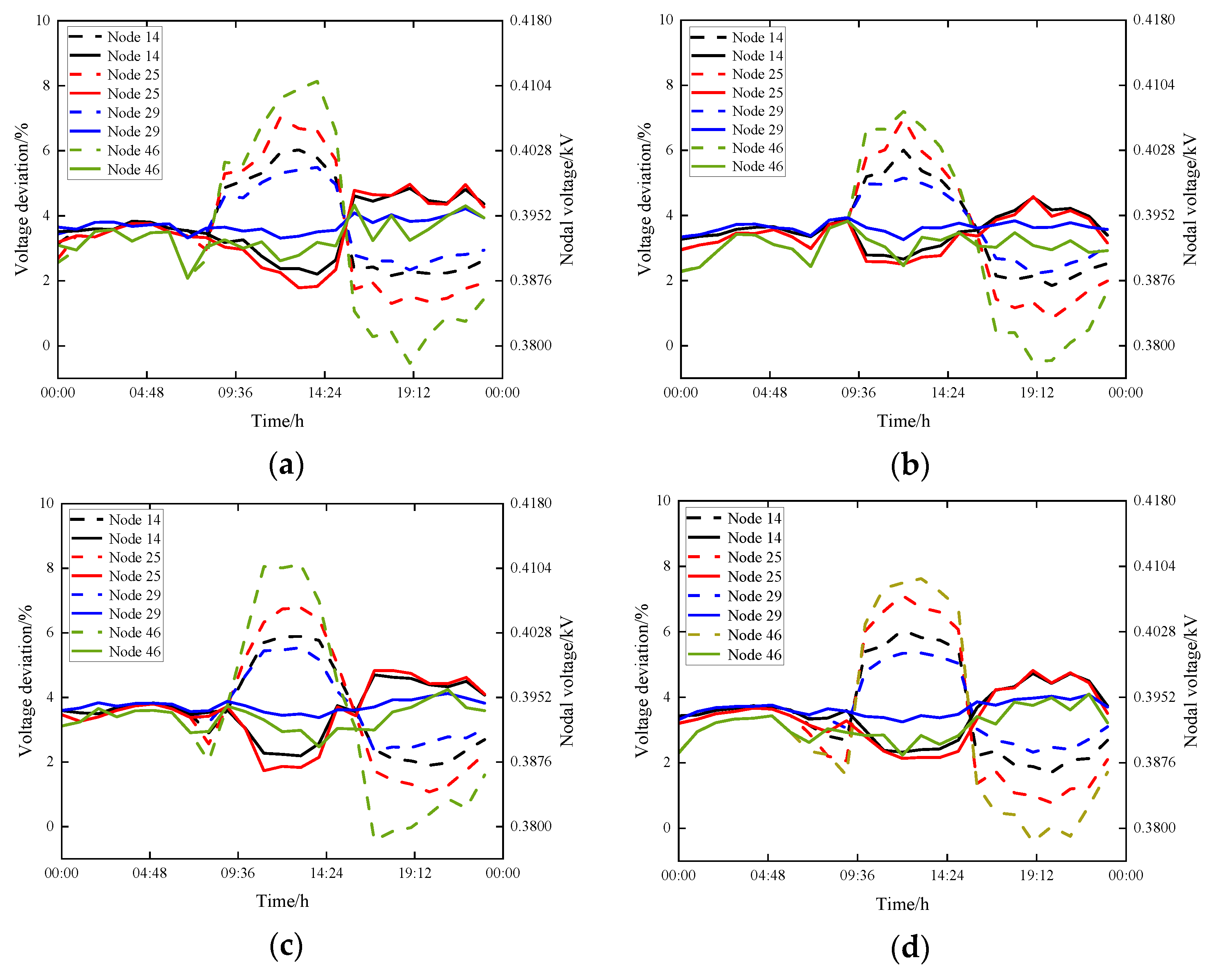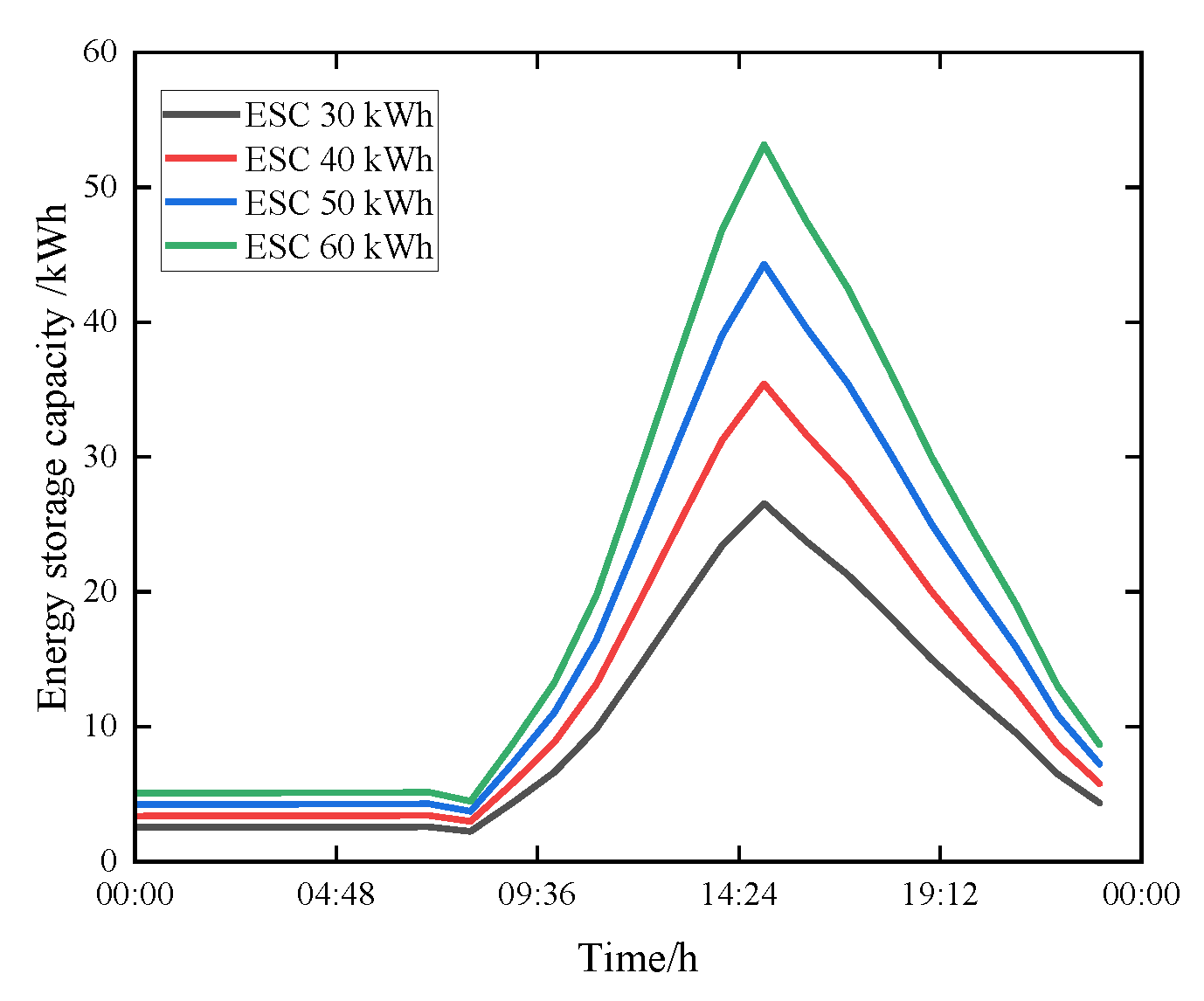Voltage Control Strategy for Low-Voltage Distribution Network with Distributed Energy Storage Participating in Regulation under Low-Carbon Background
Abstract
1. Introduction
- (1)
- A mathematical model for calculating node voltage deviation and active power loss is established by taking a high proportion of photovoltaic LVDN as the research object;
- (2)
- Based on fuzzy clustering analysis, the nodes in the LVDN are divided into two levels;
- (3)
- Considering multiple constraint equations, a mathematical model of the optimal allocation of distributed energy storage in each partition is proposed, and the model is solved by particle swarm optimization;
- (4)
- Based on sensitivity analysis, the mathematical model describing the relationship between the node voltage increment and the node injection current increment is derived, and the mathematical formulas for calculating the node out-of-limit active power, and the distributed energy storage exchange power, are proposed, and the voltage control strategy based on sensitivity analysis is proposed.
2. Calculation of Voltage and Loss of Low-Voltage Distribution Network with High Proportion of Photovoltaic
2.1. Definition of High-Proportion Photovoltaic
2.2. Calculation of Node Voltage of Low Voltage Distribution Network
2.3. Calculation of Active Power Loss in Low-Voltage Distribution Network
2.4. Calculation of Voltage Deviation
- (1)
- Set the initial voltage of the node as the rated voltage;
- (2)
- Calculate the equivalent load current , and use Formula (3) to calculate the branch current of the distribution network
- (3)
- Calculate the node voltage according to Formula (4);
- (4)
- If the voltage difference of each node in the calculation of two adjacent iterations is not within the allowed error range (1 × 10−5), then go back to step (2), otherwise go to step (5);
- (5)
- Calculate the node voltage deviation according to Formula (6), and output the voltage deviation value of each node.
3. Configuration of Distributed Energy Storage
3.1. Zoning of Low-Voltage Distribution Network
3.2. Mathematical Model of Distributed Energy Storage Configuration
3.3. Solution Method
4. Voltage Control Strategy
4.1. Sensitivity Analysis
4.2. Power Calculation of Distributed Energy Storage Exchange
4.3. Voltage Control Strategy Based on Sensitivity Analysis
5. Example Analysis
6. Conclusions
- (1)
- For a LVDN containing high proportion PV, the LVDN partition is completed according to fuzzy cluster analysis based on the time point voltage of the distribution lines running throughout the day. It is more conducive to reflecting the influence of the power supply and load imbalance on the node voltage. Nodes with similar node voltage characteristics can be divided into the same zone.
- (2)
- Considering the improvement in node voltage and a reduction in power loss, a mathematical model for the optimal allocation of distributed energy storage in partitions is established. By controlling the injected power of the distributed energy storage, the LVDN voltage is adjusted, which is more conducive to dealing with the voltage exceeding the limit caused by the imbalance of the internal load in the partitions.
- (3)
- The voltage control strategy based on sensitivity analysis can effectively solve the voltage deviation problem caused by the high proportion of PV connected to the low-voltage distribution network, ensure the voltage deviation of all nodes within the allowable range, and reduce the LVDN active power loss.
Author Contributions
Funding
Informed Consent Statement
Data Availability Statement
Conflicts of Interest
References
- Wang, C.; Zhang, J.T. Carbon Peak Carbon Neutrality Towards a New Development Path; Party School Press of the CPC Central Committee: Beijing, China, 2021; pp. 115–117. [Google Scholar]
- Chen, W.; Ai, X.; Wu, T.; Liu, H. A review of the impact of photovoltaic grid-connected power generation systems on the power grid. Electr. Power Autom. Equip. 2013, 33, 26–32. [Google Scholar]
- Zhang, L.M.; Tang, W.; Zhao, Y.J.; Wang, S.L. Analysis of DG influences on system voltage and losses in distribution network. Power Syst. Prot. Control 2011, 39, 91–96. [Google Scholar]
- Pei, Z.Y.; Ding, J.; Li, C.; Zhou, C.; Liang, Z.F.; Yu, H.; Xu, X.C.; Zhang, J. Analysis and suggestions on distributed photovoltaic grid-connected problems. Electr. Power 2018, 51, 80–87. [Google Scholar]
- Hu, X.K.; Zhang, Q.; Hu, W.P.; Meng, L.; Wang, L. Analysis of the influence of distributed photovoltaic on automatic reclosing. Power Syst. Prot. Control 2019, 47, 75–82. [Google Scholar]
- Wang, Y.; Zhang, P.; Li, W.; Xiao, W.; Abdollahi, A. Online overvoltage prevention control of photovoltaic generators in microgrids. IEEE Trans. Smart Grid 2012, 3, 2071–2078. [Google Scholar] [CrossRef]
- Wang, Y.; Tan, K.T.; Peng, X.Y.; So, P.L. Coordinated control of distributed energy-storage systems for voltage regulation in distribution Networks. IEEE Trans. Power Deliv. 2016, 31, 1132–1141. [Google Scholar] [CrossRef]
- Olivier, F.; Aristidou, P.; Ernst, D.; Van Cutsem, T. Active management of low-voltage networks for mitigating overvoltages due to photovoltaic units. IEEE Trans. Smart Grid 2016, 7, 926–936. [Google Scholar] [CrossRef]
- Li, Q.R.; Zhang, J.C. The solution of voltage overrun of distribution network with distributed photovoltaic power source. Autom. Electr. Power Syst. 2015, 39, 117–123. [Google Scholar]
- Chai, Y.Y.; Guo, L.; Wang, C.S.; Liu, J.Y.; Lu, C.; Jin, W.; Pan, J. Distributed voltage control in distribution networks with high penetration of PV. Power Syst. Technol. 2018, 42, 738–746. [Google Scholar]
- Kabir, M.N.; Mishra, Y.; Ledwich, G.; Dong, Z.Y.; Wong, K.P. Coordinated control of grid-connected photovoltaic reactive power and battery energy storage systems to improve the voltage profile of a residential distribution feeder. IEEE Trans. Ind. Inform. 2014, 10, 967–977. [Google Scholar] [CrossRef]
- Zeraati, M.; Golshan, M.E.H.; Guerrero, J.M. Distributed control of battery energy storage systems for voltage regulation in distribution networks with high PV penetration. IEEE Trans. Smart Grid 2018, 9, 3582–3593. [Google Scholar] [CrossRef]
- Caldon, R.; Turri, R.; Coppo, M. A network voltage control strategy for LV inverter interfaced users. In Proceedings of the 8th Mediterranean Conference on Power Generation, Transmission, Distribution and Energy Conversion (MEDPOWER 2012), Stevenage, UK, 1–3 October 2012; pp. 1–5. [Google Scholar]
- Alam, M.J.E.; Muttaqi, K.M.; Sutanto, D. Mitigation of rooftop solar PV impacts and evening peak support by managing available capacity of distributed energy storage systems. IEEE Trans. Power Syst. 2013, 28, 3874–3884. [Google Scholar] [CrossRef]
- Wang, C.; Yin, G.; Lin, F.; Polis, M.P.; Zhang, C.; Jiang, J. Balanced control strategies for interconnected heterogeneous battery systems. IEEE Trans. Sustain. Energy 2016, 7, 189–199. [Google Scholar] [CrossRef]
- Wang, Y.; Wen, F.S.; Zhao, B.; Zhang, X.S. Analysis and countermeasures of voltage violation problems caused by high-density distributed photovoltaics. Proc. CSEE 2016, 36, 1200–1206. [Google Scholar]
- Zhu, L.; Fu, D.; Zhai, J.W.; Chen, D. Analysis of influence of distributed photovoltaic generation upon node voltage of the distribution network. Power Syst. Autom. 2018, 40, 74–77. [Google Scholar]
- Meng, X.F.; Liu, W.Y.; Piao, Z.L.; Wang, L. A nodal analysis method of load flow in distribution network based on network topology analysis. Power Syst. Technol. 2010, 34, 140–145. [Google Scholar]
- Piao, Z.L.; Meng, X.F. Distribution Network Planning; Electric Power Press: Beijing, China, 2015; pp. 180–197. [Google Scholar]
- Meng, X.F.; Wang, J.; Wang, Y.N.; Liu, R.; Wang, H.; Zhang, H. Low-voltage control method for 10 kV distribution network considering distributed generation capability of local voltage regulation. Power Syst. Prot. Control 2019, 47, 65–72. [Google Scholar]
- Cao, B.Y. Application of Fuzzy Mathematics and Systems; Science Press: Beijing, China, 2005; pp. 165–170. [Google Scholar]
- Meng, X.F.; Wang, L.D.; Wang, X.N.; Wang, Y.N.; Liu, R.; Wang, H. Improved operation characteristics of three-phase four-wire low-voltage distribution network using distributed power supply. Power Grid Technol. 2018, 42, 4091–4100. [Google Scholar]
- Zheng, F.F.; Meng, X.F.; Wang, L.D.; Zhang, N.N. Power Flow Optimization Strategy of Distribution Network with Source and Load Storage Considering Period Clustering. Sustainability 2023, 15, 4515. [Google Scholar] [CrossRef]
- Fang, B.M.; Li, H.Z.; Kong, X.P.; Yang, Y.B. Research on long-term distributed energy storage configuration with a high proportion of photovoltaic output. Power Syst. Prot. Control 2021, 49, 121–129. [Google Scholar]
- Yu, H.J.; Li, G.J.; Yang, B.; Zhu, S.J. Research on the active control technology of grid voltage based on a distributed photovoltaic/flywheel energy storage combined generation system. Power Syst. Prot. Control 2021, 49, 48–56. [Google Scholar]
- Zheng, P.F.; Liu, X.C. Description of power quality standard system. Electr. Meas. Instrum. 2010, 47, 123–127. [Google Scholar]








| Partition Number | Number of a Node in a Zone | Distributed Energy Storage Configuration Node | Distributed Energy Storage Configuration Capacity/kW |
|---|---|---|---|
| 1 | 34 35 36 44 45 46 | 44 | 50 |
| 2 | 4 5 22 23 24 25 | 24 | 40 |
| 3 | 1 2 3 12 13 17 18 | 17 | 60 |
| 4 | 33 40 41 42 43 | 43 | 50 |
| 5 | 28 29 30 31 | 30 | 50 |
| 6 | 9 10 11 27 | 10 | 60 |
| 7 | 6 7 8 26 | 7 | 40 |
| 8 | 19 20 21 | 20 | 50 |
| 9 | 14 15 16 | 15 | 60 |
| 10 | 32 37 38 39 | 38 | 30 |
| Node Number | Node 8 | Node 17 | Node 29 | Node 46 | |||||
|---|---|---|---|---|---|---|---|---|---|
| Type | Node Voltage/kV | Voltage Deviation/% | Node Voltage/kV | Voltage Deviation/% | Node Voltage/kV | Voltage Deviation/% | Node Voltage/kV | Voltage Deviation/% | |
| spring | pre-control | 0.4063 | 6.92 | 0.4031 | 6.08 | 0.4002 | 5.32 | 0.4089 | 7.61 |
| after control | 0.3891 | 2.39 | 0.3882 | 2.16 | 0.3926 | 3.32 | 0.3899 | 2.61 | |
| summer | pre-control | 0.4063 | 6.92 | 0.4028 | 6 | 0.4003 | 5.34 | 0.4074 | 7.21 |
| after control | 0.3901 | 2.66 | 0.3887 | 2.29 | 0.3924 | 3.26 | 0.3893 | 2.45 | |
| autumn | pre-control | 0.4058 | 6.79 | 0.4025 | 5.92 | 0.4008 | 5.47 | 0.4104 | 8 |
| after control | 0.3883 | 2.18 | 0.3873 | 1.92 | 0.3931 | 3.45 | 0.3912 | 2.95 | |
| winter | pre-control | 0.4072 | 7.16 | 0.4032 | 6.11 | 0.4003 | 5.34 | 0.4085 | 7.5 |
| after control | 0.3892 | 2.42 | 0.3876 | 2 | 0.3923 | 3.24 | 0.3885 | 2.24 | |
| Time | 20 March | 21 June | 23 September | 22 December |
|---|---|---|---|---|
| Active loss of branch before control/kW | 15.426 | 14.625 | 15.0154 | 17.9742 |
| Active loss of branch after control/kW | 6.0549 | 5.7178 | 5.6496 | 7.1382 |
| Energy storage battery exchange power/kW | 748.65 | 549.99 | 647.32 | 704.31 |
| Photovoltaic Ratio | Before Optimization | After Optimization | ||
|---|---|---|---|---|
| Maximum Node Voltage Offset/% | Maximum Daily Active Power Loss of a Branch/kW | Maximum Node Voltage Offset/% | Maximum Daily Active Power Loss of a Branch/kW | |
| 40% | 5.6507 | 12.6091 | 4.084 | 13.3042 |
| 60% | 5.8596 | 12.9877 | 3.7888 | 9.5478 |
| 80% | 7.7558 | 14.6823 | 4.4727 | 6.5039 |
| 100% | 8.1414 | 17.9742 | 4.84 | 7.1382 |
Disclaimer/Publisher’s Note: The statements, opinions and data contained in all publications are solely those of the individual author(s) and contributor(s) and not of MDPI and/or the editor(s). MDPI and/or the editor(s) disclaim responsibility for any injury to people or property resulting from any ideas, methods, instructions or products referred to in the content. |
© 2023 by the authors. Licensee MDPI, Basel, Switzerland. This article is an open access article distributed under the terms and conditions of the Creative Commons Attribution (CC BY) license (https://creativecommons.org/licenses/by/4.0/).
Share and Cite
Zhu, L.; Meng, X.; Wang, L.; Zhang, N.; Wang, H. Voltage Control Strategy for Low-Voltage Distribution Network with Distributed Energy Storage Participating in Regulation under Low-Carbon Background. Sustainability 2023, 15, 9943. https://doi.org/10.3390/su15139943
Zhu L, Meng X, Wang L, Zhang N, Wang H. Voltage Control Strategy for Low-Voltage Distribution Network with Distributed Energy Storage Participating in Regulation under Low-Carbon Background. Sustainability. 2023; 15(13):9943. https://doi.org/10.3390/su15139943
Chicago/Turabian StyleZhu, Lin, Xiaofang Meng, Lidi Wang, Nannan Zhang, and Hui Wang. 2023. "Voltage Control Strategy for Low-Voltage Distribution Network with Distributed Energy Storage Participating in Regulation under Low-Carbon Background" Sustainability 15, no. 13: 9943. https://doi.org/10.3390/su15139943
APA StyleZhu, L., Meng, X., Wang, L., Zhang, N., & Wang, H. (2023). Voltage Control Strategy for Low-Voltage Distribution Network with Distributed Energy Storage Participating in Regulation under Low-Carbon Background. Sustainability, 15(13), 9943. https://doi.org/10.3390/su15139943







